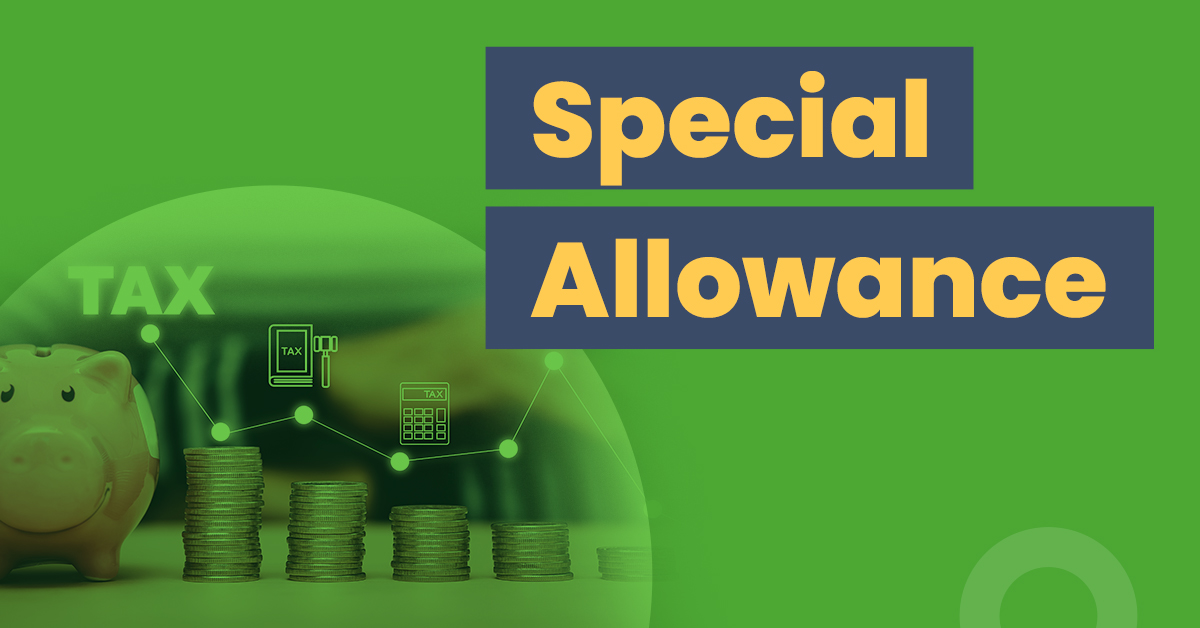Special Allowance: Calculation, Taxation, and Exemption


A special allowance is one of the many allowances an employer provides to an employee as a part of their salary. While some of this allowance is exempted, certain parts are taxable under the Income Tax law. It mainly depends on the reason for which this allowance has been granted.
Details of special allowances in India and their taxation and calculation have been explained below.
What Is Special Allowance in India?
Special allowance is given to the employees to compensate for their expenses incurred while performing their duties or job. It is a fixed payment that varies from one company to another whose details are mentioned clearly on the employee’s salary slip and offer letter. Thus, since it forms a part of salary, it is taxable under Section 10(14) of the Income Tax Act, 1961.
However, there are also special conditions in which the Government of India provides an exemption from special allowance tax under Section 10(14). These include:
- The allowance should not be categorized as a pre-requisite defined under Section 17(2). The grant should meet employees’ expenses exclusively and wholly incurred against performing his/her duty or during employment of profit. Moreover, the exemption is up to the limit of expenses incurred for the same purpose.
- Any such special allowance is exempt under the law which is allotted to compensate for the personal expenses incurred at the place of work (office)/ employment/ residence.
What Is the Taxation for Special Allowance?
Section 10(14), clause (1), and clause (2) define whether a special allowance is taxable in India or not. According to it, those parts of the allowance that do not fall in the exempt income category as per the Income Tax Act rules are fully taxable. However, for those who are exempt, it can be either partially exempt or wholly. So, it depends on which category it falls into. Also, one must remember the following conditions while calculating tax:
- The income tax department mentions the exemption limit for different categories. However, it does not put a cap on the maximum amount employers can offer.
- The expense is not personal.
- Allowance should not be in the nature of a perquisite.
- The expense should be necessarily, wholly and exclusively used for performing one’s duty or employment of profit.
- The exemption limit of allowance is up to the amount an employee spends or the employer gives, whichever is lower.
How to Calculate Special Allowance?
Taxpayers will be able to understand the calculation of special allowances by breaking down the different parts of their CTC.
What Are the Different Categories of Special Allowance and Its Exemption?
The following are the different categories of special allowances in salary given by employers to meet employees’ expenses. It shows the limit to which it is exempted:
| Special Allowance Covered u/s 10(14) | Exemption Limit |
| Hostel expenditure allowance. | Up to Rs. 300 per child per month to a maximum of 2 children. |
| Children education allowance. | Up to Rs. 100 per child per month to a maximum of 2 children. |
| Transport allowance is provided to an employee to compensate for expenses incurred for travelling to and fro from a place of residence to a place of work. | Rs. 3,200 per month is granted as an allowance to an employee who is dumb/deaf/orthopedically handicapped with a disorder of the lower extremities. |
| Transport allowance is provided to an employee to compensate for personal expenses incurred while working for a transport business. However, it is provided only when the expense is incurred during the course. It is while transporting from one place to another. Also, the employee must not get any daily allowance. | Lower of the following:-70% of the allowance-Rs. 10,000 per month |
| Conveyance allowance provided to meet the conveyance expenses to perform office duties. | Up to the extent of expenses incurred. |
| Any allowance that covers the cost of travel on a transfer or tour. | Up to the extent of expenses incurred. |
| Helper or assistance allowance. | Up to the extent of expenses incurred. |
| Daily allowance to meet the daily expense incurred ordinarily by an employee against his/her absence from the normal place of work. | Up to the extent of expenses incurred. |
| Research allowance provided to promote academic research and similar professional pursuits. | Up to the extent of expenses incurred. |
| Uniform allowance. | Up to the extent of expenses incurred. |
| Special compensatory allowance provided in hilly areas (Subject to terms and conditions). | Exempt tax value varies from Rs. 300 per month to Rs. 7000 per month. |
| Border area allowance, Distributed area allowance, Remote locality allowance or Difficult area allowance (Subject to terms and conditions). | Exempt tax value varies from Rs. 200 per month to Rs. 1300 per month. |
| Compensatory field area allowance. Upon availing this allowance employees cannot claim border area allowance. (Subject to terms and conditions) | Rs. 2600 per month |
| Tribal area allowance (in Tamil Nadu, Madhya Pradesh, West Bengal, Tripura, Orissa, Bihar, Assam, Karnataka, and Uttar Pradesh) | Rs. 200 per month |
| Compensatory modified area allowance. Upon availing this allowance, employees cannot claim border area allowance. (Subject to terms and conditions) | Rs. 1000 per month |
| Counter-insurgency allowance provided to Army Force members operating from a location other than their permanent residence. Upon availing this allowance employees cannot claim border area allowance. (Subject to terms and conditions). | Rs. 3900 per month. |
| Underground allowance provided to employees serving in unnatural climates, uncongenial conditions like underground mines. | Rs. 800 per month. |
| Highly active field area allowance provided to members of the army force (Subject to terms and condition). | Up to Rs. 4200 per month. |
| Island duty allowance granted to members of the armed force. | Up to Rs. 3250 per month. |
| High altitude allowance provided to members of army forces running operations in high altitude areas. (Subject to terms and conditions). | -Up to Rs. 1060 per month (for altitudes ranging between 9000 and 15000 feet).-Up to Rs. 1600 per month (for altitudes ranging above 15000 feet). |
Illustration
Taxpayers will be able to understand the calculation of special allowances by breaking down the different parts of their CTC.
Categories that form fixed pay of the CTC
- Basic salary forms 40% of the CTC.
- HRA or House Rent Allowance can be 50% of the basic salary. It depends on where the employee stays.
- Dearness Allowance forms 20% of the basic salary. The company fixes it, and it is taxable.
- Medical Reimbursement is ₹15,000 annually, i.e., Rs. 1250 per month.
- The special allowance depends on the company policy and is taxable.
- LTA or Leave Travel Allowance varies from company to company. The exemption is only up to a certain limit.
- Food coupons (varies as per company policy).
CTC also often includes variable pay that employers provide additionally. It includes:
- Performance-based commission/bonus (8.33 to 20% of the Gross Pay).
- Employer’s contribution to PF or Provident Fund (13.61% of the Basic Pay).
- Mediclaim (Varies as per company policy and differs for multiple companies).
- Gratuity (varies according to government rules and company norms).
So, the calculation of the special allowance given to Mr A. will be as under if his CTC is ₹10 lakh.
| Particulars | Amount in Rs. |
| CTC | ₹10,00,000 |
| Basic Salary | ₹4,00,000 |
| HRA | ₹2,00,000 |
| Medical Reimbursement | ₹15,000 |
| Special Allowance | ₹3,85,000 |
Special allowance per month will be ₹32,083.
This allowance is then sub-categorised and calculated considering the exemptions mentioned below.
Final Word
This is all the information on ‘What is special allowance in India?’, its taxation, calculation and exemption. To sum up, employees receive this allowance as part of their total CTC in exchange for their expenses. Section 10(14) of the Income Tax Act provides different conditions under which certain amounts are exempt while others are taxable.
Frequently Asked Questions (FAQ’s)
What is the difference between allowance and perquisite?
Allowances are monetary benefits granted by employers to employees for whatever reason. For example, house rent allowance, travel allowance, etc. However, perquisites are monetary or non-monetary facilities provided for numerous services performed by the employees.
What is the difference between special allowance and dearness allowance?
What is the difference between special allowance and dearness allowance?
Special allowance is different from dearness allowance and influences calculations also. Please note the dearness allowance is applicable to public sector employees only and not the private sector. Special allowances paid do carry certain exemptions, as highlighted above, while dearness allowance is taxable.
What are examples of allowances?
Depending on the employer, an individual may receive different allowances. Some of the most common examples include House Rent Allowance, Leave Travel Allowance, Uniform Allowance, Conveyance Allowance, and Transport Allowance, among others.
What are the 3 types of allowances?
Salary allowances can be classified into three different types based on taxability – fully exempt allowances, partially taxable allowances, and fully taxable allowances.



